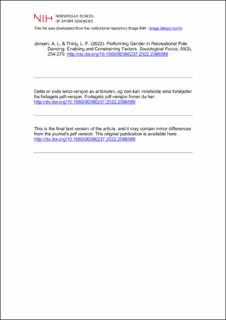| dc.contributor.author | Jensen, Andorra L. | |
| dc.contributor.author | Thing, Lone Friis | |
| dc.date.accessioned | 2023-10-24T12:08:19Z | |
| dc.date.available | 2023-10-24T12:08:19Z | |
| dc.date.created | 2022-04-26T08:02:10Z | |
| dc.date.issued | 2022 | |
| dc.identifier.citation | Sociological Focus. 2022, 55(3), 254-270. | en_US |
| dc.identifier.issn | 0038-0237 | |
| dc.identifier.uri | https://hdl.handle.net/11250/3098415 | |
| dc.description | I Brage finner du siste tekst-versjon av artikkelen, og den kan inneholde ubetydelige forskjeller fra forlagets pdf-versjon. Forlagets pdf-versjon finner du på tandfonline.com / In Brage you'll find the final text version of the article, and it may contain insignificant differences from the journal's pdf version. The definitive version is available at tandfonline.com | en_US |
| dc.description.abstract | Many people consider pole dancing to be a feminine leisure activity and a female dominated space, but it has recently gained observer status in the Global Association of International Sports Federation (GAISF), thus entering into the field of sport where hegemonic masculinity has historically prevailed. The strong connections between gender, body, and sport and the gender inequalities that permeate the sports culture make it interesting to explore the enabling and constraining factors of performing gender in recreational (i.e., nonoccupational) pole dancing, which is the aim of this article. The methodical approach is qualitative and inspired by ethnography. The article is based on a field study done in Copenhagen, Denmark, including observation, participation, and interviews. The theoretical perspective takes its point of departure in Judith Butler’s theory in Gender Trouble. First, the authors found that the body ideal in pole dance includes both feminine and masculine qualities. The analysis also shows that the different styles of pole dancing (i.e., “sportified” or “sexualized”) and the context in which pole dancing is practiced (i.e., women only or mixed sex) makes a difference regarding what enables and constrains men and women when it comes to performing gender. Inspired by Butler, the authors also discuss which possibilities pole dancing holds for performing gender in new ways, thus challenging oppressive gender norms. Finally, the authors discuss the implications of pole dance becoming a sport in relation to the possibilities of performing gender. | en_US |
| dc.description.abstract | Performing Gender in Recreational Pole Dancing: Enabling and Constraining Factors | en_US |
| dc.language.iso | eng | en_US |
| dc.subject | pole dancing | en_US |
| dc.subject | gender | en_US |
| dc.title | Performing Gender in Recreational Pole Dancing: Enabling and Constraining Factors | en_US |
| dc.title.alternative | Performing Gender in Recreational Pole Dancing: Enabling and Constraining Factors | en_US |
| dc.type | Peer reviewed | en_US |
| dc.type | Journal article | en_US |
| dc.description.version | acceptedVersion | en_US |
| dc.source.pagenumber | 254-270 | en_US |
| dc.source.volume | 55 | en_US |
| dc.source.journal | Sociological Focus | en_US |
| dc.source.issue | 3 | en_US |
| dc.identifier.doi | 10.1080/00380237.2022.2066589 | |
| dc.identifier.cristin | 2019070 | |
| dc.description.localcode | Institutt for idrett og samfunnsvitenskap / Department of Sport and Social Sciences | en_US |
| cristin.ispublished | true | |
| cristin.fulltext | postprint | |
| cristin.qualitycode | 1 | |
